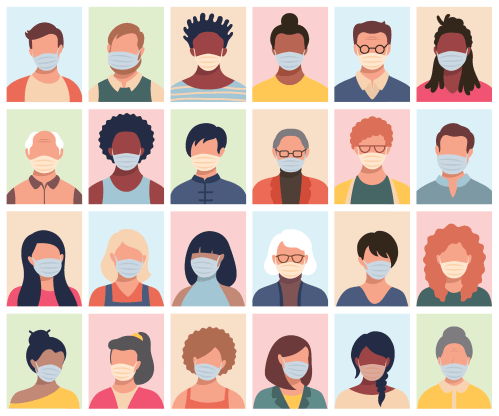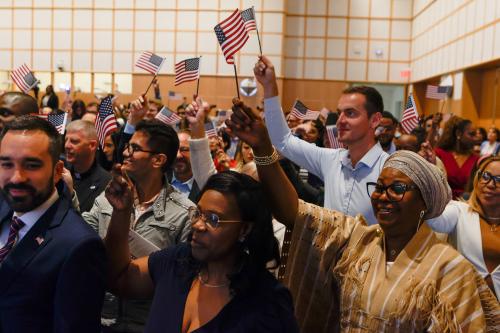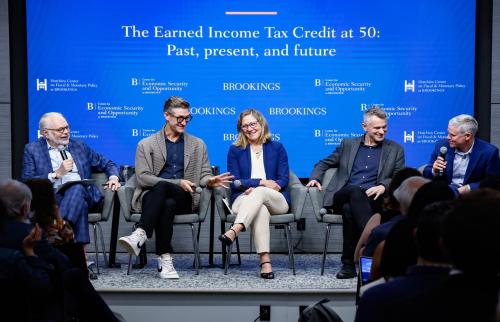This blog was updated on Nov. 4, 2021 to correct an error: The overall death rate for men is 1.6 times as high as the death rate for women, not 1.6 times higher.
Men are much more likely to die from COVID-19 than women. This is true globally – where the death rate has been about 50% higher for men. Notably, this gap does not appear to be explained either by differences in the number of confirmed cases or in pre-existing conditions. With the pandemic cutting life expectancy of American men by more than two years, it is important to understand and mitigate risks associated with COVID-19 mortality among men.
Building on earlier work with Tiffany Ford from May 2020, “COVID-19 much more fatal for men, especially taking age into account,” we draw here on updated CDC data to examine the gender mortality gap by age, and over time in the U.S. Our main findings are:
- The overall death rate for men is 1.6 times the death rate for women;
- The gap is widest in the middle of the age distribution, with 184 male deaths for every 100 female deaths.
- As death rates have fallen, the gender gap has narrowed slightly
- The gap is not explained by a higher number of cases among men, or differences in pre-existing conditions
- In Georgia and Michigan, Black men have the highest death rates, followed by Black women
- Improving access to care and addressing vaccine hesitancy, especially for Black men, should be a high priority
The gender gap in death rates
Men have had a higher crude death rate than women, as the chart using CDC data from February 2020 to August 2021 shows. By the end of August, over 65,000 more men than women had died from COVID-19 (362,187 male deaths and 296,567 female deaths).

The gender gap is even wider when differences in the male and female age distributions are taken into account, since there are many more older women than men in the population, and age is the biggest risk factor in COVID deaths. In 2021, mortality rates for men and women have dropped sharply, but somewhat faster for men than women, leading to a slight narrowing of the gap over time. More recently, though, death rates for men and women have risen again due to the spread of the Delta variant, with greater increases among men than women.
Middle-aged men are especially vulnerable
The picture varies across the age distribution, however. The gap is largest for those towards the middle of the age distribution. Among those aged 45 to 64, for example, the number of male deaths as of September 15, 2021, was 79,711, almost twice the number of female deaths, at 45,587.

We also calculate the ratio in death rates (male death rate: female death rate) in COVID-19 mortality for specific age groups. For all age groups, we calculate a similar ratio, but age-standardize the death rates. As of September 15, 2021, the overall adjusted male death rate was 1.63 times the overall adjusted female death rate. This means that men make up 62% of all (age-standardized) COVID deaths. Again, the male-female gap is most prominent in those at or just past middle age: among those aged 45-64, there are 184 male deaths for every 100 female deaths.

COVID cases similar for men and women…
One possible explanation for the mortality gap could be that men are more likely to contract COVID-19. But while it is difficult to assess case counts due to access and demand for testing, raw data on the number of cases by age and sex from the CDC suggest very similar levels for men and women (note that the age brackets are not exactly the same as shown above, because of the way CDC data is presented).
In fact, women have slightly higher case numbers, possibly because they may make up a greater share of riskier jobs that are high-contact and inflexible, such as healthcare support, personal care and services, and food preparation (although it is important to acknowledge that men make up a greater share of those in high-risk jobs like meatpacking). Likewise, these industries might require more routine testing, leading to an over-reporting in mild/asymptomatic cases. On the other hand, men might be less likely to test for asymptomatic cases, leading to less reported cases overall. Correcting for these measurement issues would give a more accurate comparison of COVID-19 cases by sex.

…and pre-existing conditions do not explain the gap
Another possible explanation for the mortality gap is a higher rate of pre-existing conditions among men that make them more vulnerable to the virus. Again, some evidence suggests that this is not a major factor. One study of an Illinois hospital system by Joanne Michelle Gomez and co-authors, published in the Journal of Women’s Health, concluded that “male sex was independently associated with death, hospitalization, ICU admissions, and need for vasopressors or endotracheal intubation, after correction for important covariates.”
Another review of risk factors for hospitalization finds that men and women have similar rates of conditions associated with greater vulnerability, although there are some differences in specific conditions. For instance, “obesity, chronic kidney disease and hypertension were associated with higher rates of ICU admission among men, whereas obesity and heart failure were associated with higher rates of ICU admission among women.” These sex-specific differences make it important to better understand the relationship between sex, risk factors, and COVID-19 mortality, especially for different age cohorts and racial groups. As we discuss below, biological differences by sex are not the same across race, and there are additional factors at play that drive differences in death rates among women.
The gender gap has changed over the pandemic
The mortality gap has somewhat narrowed for some age groups since the start of 2021. Figure 5 shows that the death rate ratio for middle-aged adults was around 1.8 prior to February 2021. More recently, this ratio has leveled around 1.5, representing a decline of around 17 percent.

Black men fare worst of all
There are of course other gaps in vulnerability to COVID-19, especially by race. Our previous study from the earlier stages of the pandemic “Race gaps in COVID-19 deaths are even bigger than they appear” showed for example that among middle-aged adults, Black and Hispanic or Latino death rates are six times higher than those for white people.
This means that while there is a gap between men and women within racial groups, race is often a bigger factor. Tamara Rushovich and her colleagues, drawing on data from Georgia and Michigan, find that while Black men have the highest COVID mortality rates – six times higher than for white men – the next most vulnerable group is Black women. They also find that the sex gap varies by race, especially in Michigan, where, as they report, “the mortality rate for Black men is 170% times the rate for Black women, which is significantly higher than the equivalent ratio among white individuals: the rate is only 130% higher for white men compared to white women.”
Interestingly, the authors also point out that the COVID mortality gap between Black women and white women is significantly greater than the gap between white men and white women. This suggests that the biological sex differences in mortality cannot be treated as constant across all racial groups.

Rushovich and her co-authors also do not put much weight on “individual behaviors and beliefs” to explain the race or sex gaps in mortality (or indeed sex gaps within race), pointing instead to “structural factors including occupation and access to healthcare.” This seems right, but it is nonetheless important to understand potential behavioral reasons behind the disparate death rates, especially as it relates to the decision to get vaccinated.
Get men (especially Black men) vaccinated
The gender gap in COVID-19 mortality is the result of a combination of factors, which may differ by race, class, geography and other variables. This is a stark reminder of the need for disaggregated health data to inform an intersectional approach to analysis. Gaining a better understanding of biological differences, case counts, and risk factors will be an ongoing task for scientific researchers.
More immediately, an urgent public health priority is to encourage and incentivize those most vulnerable to the virus to get vaccinated. Both race and gender matter here. As of September 21, 2021, Black Americans were six percentage points less likely than white Americans to have had at least one vaccine dose (41% compared to 35%). The racial disparity in vaccination rates is likely due to a combination of persistent barriers to access and structural inequities, which not only includes geographical access, but also logistics, methods of communication, timing, and registration. Many cities such as Philadelphia have facilitated better access to their underserved Black communities by partnering with community churches, opening alternative vaccination facilities such as local pharmacies, and using more direct methods of communication rather than with emails and Web portals. But while this has worked to some extent, there remain considerable gaps in vaccination take-up by race. Even among health care workers who had early and constant access to vaccines, Black workers were almost five times more likely than white workers to be hesitant about getting vaccinated. Our colleagues Sarah Reber and Cyrus Kosar also find that Black nursing home residents are likely to be in high-risk facilities with low vaccination rates, despite being one of the first few groups offered the vaccine.
What this means is that, in addition to improving access for underserved communities, we need additional research on the interventions that can effectively address hesitancy and increase demand for vaccine uptake. The Washington Post reports that “tapping into the communities where people live, drawing on information, outreach and vaccine administrators from those communities” is one good way to overcome hesitancy.
In addition to the racial gaps in vaccine rates, there is a gender gap too: 66% of women have had at least one vaccine dose, compared to 62% of men. Many states are also offering various vaccine incentive schemes – it may be worth seeing which have proven most effective with men. Especially with the spread of the new Delta variant, improving access and addressing vaccine hesitancy among the most vulnerable groups – including men, and especially Black men – must be a high priority for policymakers.
The Brookings Institution is financed through the support of a diverse array of foundations, corporations, governments, individuals, as well as an endowment. A list of donors can be found in our annual reports published online here. The findings, interpretations, and conclusions in this report are solely those of its author(s) and are not influenced by any donation.
The Brookings Institution is committed to quality, independence, and impact.
We are supported by a diverse array of funders. In line with our values and policies, each Brookings publication represents the sole views of its author(s).








Commentary
At least 65,000 more men than women have died from COVID-19 in the US
October 19, 2021